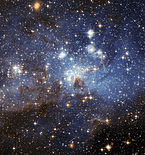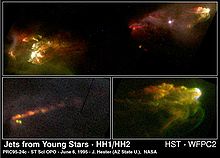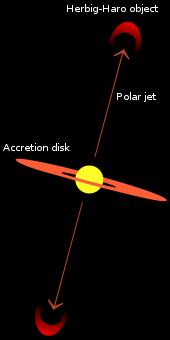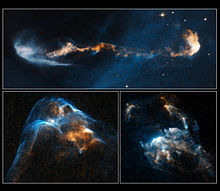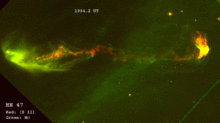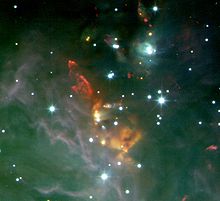
Herbig–Haro object
Background Information
SOS Children made this Wikipedia selection alongside other schools resources. Click here to find out about child sponsorship.

Herbig–Haro objects (HH) are small patches of nebulosity associated with newly born stars, and are formed when narrow jets of gas ejected by young stars collide with clouds of gas and dust nearby at speeds of several hundred kilometres per second. Herbig–Haro objects are ubiquitous in star-forming regions, and several are often seen around a single star, aligned with its rotational axis.
HH objects are transient phenomena, lasting not more than a few thousand years. They can evolve visibly over quite short timescales as they move rapidly away from their parent star into the gas clouds of interstellar space (the interstellar medium or ISM). Hubble Space Telescope observations have revealed the complex evolution of HH objects over the period of a few years, as parts of the nebula fade while others brighten as they collide with clumpy material of the interstellar medium.
The objects were first observed in the late 19th century by Sherburne Wesley Burnham, but were not recognised as being a distinct type of emission nebula until the 1940s. The first astronomers to study them in detail were George Herbig and Guillermo Haro, after whom they have been named. Herbig and Haro were working independently on studies of star formation when they first analysed the objects, and recognised that they were a by-product of the star formation process.
Discovery and history of observations
The first HH object was observed in the late 19th century by Burnham, when he observed the star T Tauri with the 36-inch (910 mm) refracting telescope at Lick Observatory and noted a small patch of nebulosity nearby. However, it was catalogued merely as an emission nebula, later becoming known as Burnham's Nebula, and was not recognised as a distinct class of object. However, T Tauri was found to be a very young and variable star, and is the prototype of the class of similar objects known as T Tauri stars which have yet to reach a state of hydrostatic equilibrium between gravitational collapse and energy generation through nuclear fusion at their centres.
Fifty years after Burnham's discovery, several similar nebulae were discovered which were so small as to be almost star-like in appearance. Both Haro and Herbig made independent observations of several of these objects during the 1940s. Herbig also looked at Burnham's Nebula and found it displayed an unusual electromagnetic spectrum, with prominent emission lines of hydrogen, sulfur and oxygen. Haro found that all the objects of this type were invisible in infrared light.
Following their independent discoveries, Herbig and Haro met at an astronomy conference in Tucson, Arizona. Herbig had initially paid little attention to the objects he had discovered, being primarily concerned with the nearby stars, but on hearing Haro's findings he carried out more detailed studies of them. The Soviet astronomer Viktor Hambardzumyan gave the objects their name, and based on their occurrence near young stars (a few hundred thousand years old), suggested they might represent an early stage in the formation of T Tauri stars.
Studies showed HH objects were highly ionised, and early theorists speculated they might contain low-luminosity hot stars. However, the absence of infrared radiation from the nebulae meant there could not be stars within them, as these would have emitted abundant infrared light. Later studies suggested the nebulae might contain protostars, but eventually HH objects came to be understood as material ejected from nearby young stars that is colliding at supersonic speeds with the ISM, with the resulting shock waves generating visible light.
In the early 1980s, observations revealed for the first time the jet-like nature of most HH objects. This led to the understanding that the material ejected to form HH objects is highly collimated (concentrated into narrow jets). A forming star is often surrounded by accretion disc in their first few hundred thousand years of existence. As gas falls onto them, the rapid rotation of the inner parts of these disks leads to the emission of narrow jets of partially ionized gas (plasma) perpendicular to the disk, known as polar jets. When these jets collide with the interstellar medium, they give rise to the small patches of bright emission which comprise HH objects.
Physical characteristics
Electromagnetic emission from HH objects is caused when shock waves collide with the interstellar medium, but their motions are complicated. Spectroscopic observations of their doppler shifts indicate velocities of several hundred kilometres per second, but the emission lines in those spectra are too weak to have been formed in such high speed collisions. This suggests that some of the material they are colliding with is also moving along the beam, although at a lower speed.
The total mass being ejected to form typical HH objects is estimated to be of the order of 1–20 Earth-masses, a very small amount of material compared to the mass of the stars themselves. The temperatures observed in HH objects are typically about 8000–12,000 K, similar to those found in other ionized nebulae such as H II regions and planetary nebulae. They tend to be quite dense, ranging from a few thousand to a few tens of thousands of particles per cm3, compared to generally less than 1000/cm3 in H II regions and planetary nebulae. HH objects consist mostly of hydrogen and helium, which account for about 75% and 25% respectively of their mass. Less than 1% of the mass of HH objects is made up of heavier chemical elements, and the abundances of these are generally similar to those measured in nearby young stars.
Near to the source star, about 20–30% of the gas in HH objects is ionised, but this proportion decreases at increasing distances. This implies the material is ionised in the polar jet, and recombines as it moves away from the star, rather than being ionised by later collisions. Shocking at the end of the jet can re-ionise some material, however, giving rise to bright "caps" at the ends of the jets.
Numbers and distribution
Over 400 individual HH objects or groups are now known. They are ubiquitous in star-forming H II regions, and are often found in large groups. They are typically observed near Bok globules ( dark nebulae which contain very young stars) and often emanate from them. Frequently, several HH objects are seen near a single energy source, forming a string of objects along the line of the polar axis of the parent star.
The number of known HH objects has increased rapidly over the last few years, but is still thought to be a very small proportion of the estimated of up to 150,000 in the Milky Way, the vast majority of which are too far away to be resolved. Most HH objects lie within 0.5 parsecs of their parent star, with very few found more than 1 pc away. However, some are seen several parsecs away, perhaps implying the interstellar medium is not very dense in their vicinity, allowing them to travel further from their source before dispersing.
Proper motions and variability
Spectroscopic observations of HH objects show they are moving away from the source stars at speeds of 100 to 1000 km/s. In recent years, the high optical resolution of Hubble Space Telescope has revealed the proper motion of many HH objects in observations spaced several years apart. These observations have also allowed estimates of the distances of some HH objects via the expansion parallax method.
As they move away from the parent star, HH objects evolve significantly, varying in brightness on timescales of a few years. Individual knots within an object may brighten and fade or disappear entirely, while new knots have been seen to appear. As well as changes caused by interactions with the ISM, interactions between jets moving at different speeds within HH objects also cause variations.
The eruption of jets from the parent stars occurs in pulses rather than as a steady stream. The pulses may produce jets of gas moving in the same direction but at different speeds, and interactions between different jets create so-called "working surfaces", where streams of gases collide and generate shock waves.
Infrared counterparts (MHOs)
Herbig–Haro (HH) objects associated with very young stars or very massive protostars are often hidden from view at optical wavelengths by the cloud of gas and dust from which they form. This surrounding natal material can produce tens or even hundreds of visual magnitudes of diminishment at optical wavelengths. Such deeply embedded objects can only be observed at infrared or radio wavelengths, usually in the frequencies of hot molecular hydrogen or warm carbon monoxide emission.
In recent years, infrared images have revealed dozens of examples of "infrared HH objects". Most look like bow waves (similar to the waves at the head of a ship), and so are usually referred to as molecular "bow shocks". Like HH objects, these supersonic shocks are driven by collimated jets from the opposite poles of a protostar. They sweep up or "entrain" the surrounding dense molecular gas to form a continuous flow of material, which is referred to as a bipolar outflow. Infrared bow shocks travel at hundreds of kilometers per second, heating gas to hundreds or even thousands of kelvin. Because they are associated with the youngest stars, where accretion is particularly strong. Infrared bow shocks are usually associated with more powerful jets than their optical HH cousins.
The physics of infrared bow shocks can be understood in much the same way as that of HH objects, since these objects are essentially the same – it is only the conditions in the jet and surrounding cloud that are different, causing infrared emission from molecules rather than optical emission from atoms and ions.
In 2009 the acronym "MHO", for Molecular Hydrogen emission-line Object, was approved for these objects by the International Astronomical Union Working Group on Designations, and has been entered into their on-line Reference Dictionary of Nomenclature of Celestial Objects. The MHO catalogue (see external links below) contains over 1000 objects.
